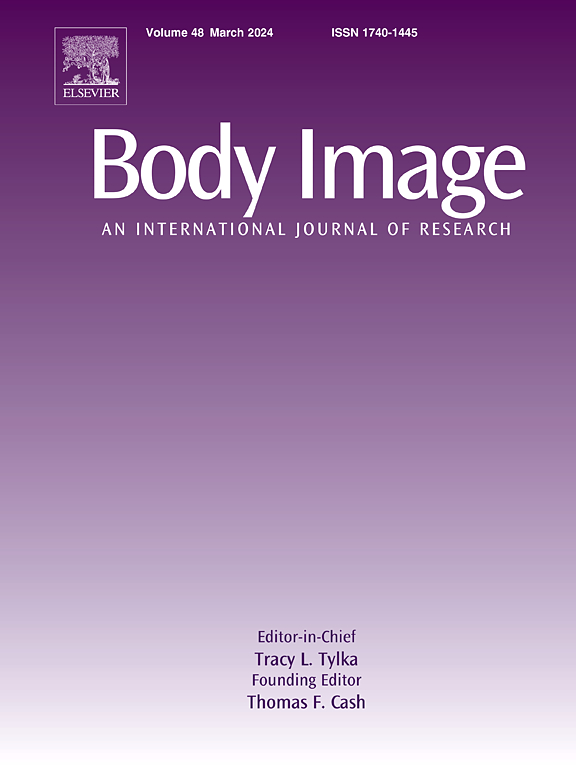意大利青少年的身体形象与社会文化影响:使用社会文化对外貌的态度问卷调查-4-修订版
IF 5.4
1区 心理学
Q1 PSYCHIATRY
引用次数: 0
摘要
身体不满和饮食失调(EDs)在青少年中非常普遍,给这一群体带来了沉重的负担。因此,迫切需要对这些问题的危险因素进行更深入的研究。在这方面,采用社会文化框架可以提供有价值的见解;然而,对青少年外貌相关的社会文化压力的评估研究仍然有限。本研究旨在验证意大利13-17岁青少年对外表的社会文化态度问卷-4-修订版(SATAQ-4R)。共有692名女孩(Mage = 15.5岁± 1.16)和450名男孩(Mage = 15.2岁± 1.21)完成了SATAQ-4R的女性和男性版本,以及其他自我报告工具,评估ED症状、身体不满、自尊、同伴和家庭外表压力、对肌肉的驱动以及Instagram外观比较的频率。为了研究SATAQ-4R的因素结构,我们对几个模型进行了检验。测量不变性在早期和中期青少年群体,信度和效度进行了讨论。最初的7因素模型对男孩和女孩的数据都产生了最好的拟合。这个模型在不同年龄组中也是不变的。SATAQ-4R-Male和SATAQ-4R-Female在构念效度和标准效度以及内部一致性方面均表现出优异的心理测量特性(saaq - 4r - male的麦当劳ω值为0.79 ~ 0.93,SATAQ-4R-Female的麦当劳ω值为0.82 ~ 0.93)。因此,SATAQ-4R可以被认为是衡量社会对意大利青少年身体形象影响的有效和可靠的工具。讨论了研究和实际意义。本文章由计算机程序翻译,如有差异,请以英文原文为准。
Italian adolescents' body image and sociocultural influences: An investigation using the Sociocultural Attitudes Towards Appearance Questionnaire-4-Revised
Body dissatisfaction and eating disorders (EDs) are highly prevalent among adolescents, imposing a significant burden on this group. Therefore, a deeper investigation into the risk factors of these issues is urgently needed. In this regard, adopting a sociocultural framework can offer valuable insights; however, research on the assessment of appearance-related sociocultural pressures among adolescents remains limited. This study aimed to validate the Sociocultural Attitude Towards Appearance Questionnaire-4-Revised (SATAQ-4R) among Italian adolescents aged 13–17 years. A total of 692 girls (Mage = 15.5 years ± 1.16) and 450 boys (Mage = 15.2 years ± 1.21) completed the Female and Male versions of the SATAQ-4R along with other self-report tools assessing ED symptoms, body dissatisfaction, self-esteem, peer and family appearance pressure, drive for muscularity, and frequency of Instagram appearance comparisons. To investigate the SATAQ-4R factor structure, several models were tested. Measurement invariance across early and middle adolescent groups, reliability, and validity were addressed. The original 7-factor model yielded the best fit to the data for both boys and girls. This model was also invariant across age groups. Both the SATAQ-4R-Male and Female exhibited excellent psychometric properties in terms of construct and criterion validity, as well as internal consistency (McDonald’s omega values ranging from .79 to .93 for the SARAQ-4R-Male and from .82 to .93 for the SATAQ-4R-Female). Therefore, the SATAQ-4R can be considered a valid and reliable tool for measuring societal influences on body image among Italian adolescents. Research and practical implications are discussed.
求助全文
通过发布文献求助,成功后即可免费获取论文全文。
去求助
来源期刊

Body Image
Multiple-
CiteScore
8.70
自引率
28.80%
发文量
174
期刊介绍:
Body Image is an international, peer-reviewed journal that publishes high-quality, scientific articles on body image and human physical appearance. Body Image is a multi-faceted concept that refers to persons perceptions and attitudes about their own body, particularly but not exclusively its appearance. The journal invites contributions from a broad range of disciplines-psychological science, other social and behavioral sciences, and medical and health sciences. The journal publishes original research articles, brief research reports, theoretical and review papers, and science-based practitioner reports of interest. Dissertation abstracts are also published online, and the journal gives an annual award for the best doctoral dissertation in this field.
 求助内容:
求助内容: 应助结果提醒方式:
应助结果提醒方式:


